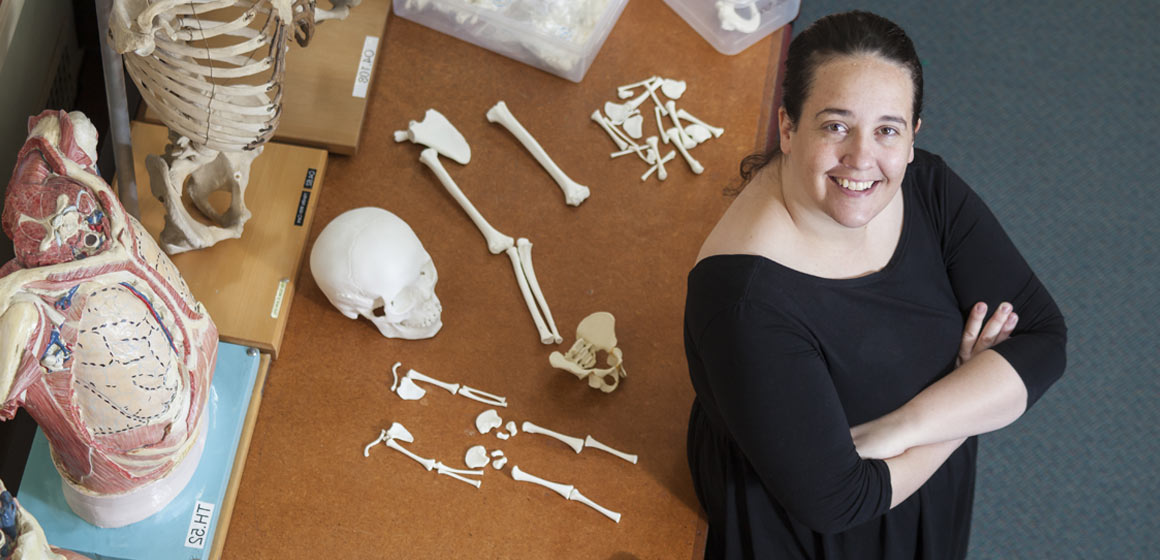
The work of bioarchaeologist Dr Sian Halcrow can be likened to that of a modern-day detective – except her clues are ancient, locked inside the bones and teeth of people who lived thousands of years ago.
“Human skeletons can tell us a lot about people's lives in the past,” says Halcrow, of the Department of Anatomy. “Archaeologists look at material culture; bioarchaeologists look at the individuals themselves.”
Halcrow's research interest lies in the effects of major social and environmental changes on human life in prehistoric times, in particular the impact of agricultural intensification and the associated social transformation.
She uncovers vital indicators of a population's general health by closely studying the bones and teeth of its members at both the macroscopic and microscopic level. This painstaking work includes assessing age at time of death, sex, chemical analyses of diet and time of weaning, demographic change and evidence of stress and pathology.
The bioarchaeologist has spent the last few years researching prehistoric populations in South-East Asia, including analysis of the remains of infants and children from eight different cemetery sites in parts of Thailand. The sites date from 4,000 years ago, when agricultural development in the area began, to the end of the Iron Age around 1,500 years ago. She also works on research projects in Cambodia and Indonesia.
“It wasn't until we developed agriculture that a massive explosion in population size took place, that we became reliant on the agricultural staples that we have today, and inequality in access to resources arose. I'm looking at the birth of that era.”
“What we found is that the evidence for temporal health change doesn't fit with the models applied in other areas of the world,” she says, explaining that the generally-accepted bioarchaeological principle – based largely on research undertaken on prehistoric peoples from temperate climates – is that population health deteriorated as a result of agricultural intensification.
“In early North America and Europe, where people were more dependent on one or two crops, bioarchaeologists argue that there's a major change in terms of health, demography and levels of infectious disease with the development of agriculture because population tended to become reliant on fewer food sources – poorer nutrition and more prone to crop failure – and also became more sedentary, with more insanitary conditions.”
Halcrow believes that the South-East Asian evidence may buck this trend, in part because of the availability of a wide range of food types in the tropical environment and the slower development of intensified agricultural processes.
Now her new research project, involving a set of more than 1,500 human skeletons from Northern Chile, will give her the opportunity to test the universally-applied model on a large and remarkably well-preserved sample from a very different environment in the Americas.
“This area is the most arid in the world – so the bone is superbly preserved and there is often natural mummification. This area is also renowned archaeologically because it has the earliest evidence of artificial mummification, pre-dating Egyptian mummification by over 2,000 years. The skeletal remains span from pre-agricultural times right through to the development of civilization, making it perfect for investigating the effects of agriculture on these populations. So it's a unique set of remains.”
Already Halcrow is excited by findings from other researchers that indicate the impact of agricultural development in the prehistoric Chilean population also may not follow the widely-accepted rule.
She says the public health consequences of agricultural intensification are still very much in evidence today and drive her interest in the topic.
“Today, more than half the people in the world go hungry, have no access to proper medical care, and live in poverty and overcrowded situations. Ultimately this stems from the development of agriculture and industrialisation. It wasn't until we developed agriculture that a massive explosion in population size took place, that we became reliant on the agricultural staples that we have today, and inequality in access to resources arose. I'm looking at the birth of that era.”
Funding
- Marsden Fund
- University of Otago Research Grant
- Health Sciences Career Development Postdoctoral Fellowship
- Otago School of Medical Sciences Dean's Strategic Research Fund
- Fulbright New Zealand